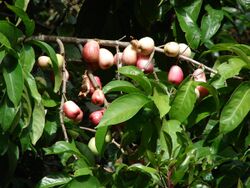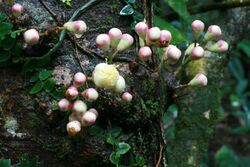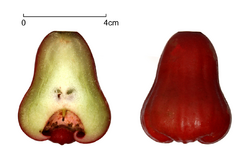Biology:Syzygium
| Syzygium | |
|---|---|

| |
| Syzygium malaccense | |
| Scientific classification | |
| Kingdom: | Plantae |
| Clade: | Tracheophytes |
| Clade: | Angiosperms |
| Clade: | Eudicots |
| Clade: | Rosids |
| Order: | Myrtales |
| Family: | Myrtaceae |
| Subfamily: | Myrtoideae |
| Tribe: | Syzygieae |
| Genus: | Syzygium P. Browne ex Gaertn.[1] |
| Species | |
|
About 1100; see List of Syzygium species | |
| Synonyms[2] | |
|
List
| |
Syzygium (/sɪˈzɪdʒiːəm/)[3] is a genus of flowering plants that belongs to the myrtle family, Myrtaceae. The genus comprises about 1200 species,[4][5][6] and has a native range that extends from Africa and Madagascar through southern Asia east through the Pacific.[7] Its highest levels of diversity occur from Malaysia to northeastern Australia , where many species are very poorly known and many more have not been described taxonomically. One indication of this diversity is in leaf size, ranging from as little as a half inch (one cm) to as great as 4 ft 11 inches (1.5 meters) by sixteen inches (38 centimeters) in Syzygium acre of New Caledonia.[8]
Most species are evergreen trees and shrubs. Several species are grown as ornamental plants for their attractive glossy foliage, and a few produce edible fruits called roseapples that are eaten fresh or used in jams and jellies. The most economically important species, however, is the clove Syzygium aromaticum, of which the unopened flower buds are an important spice. Some of the edible species of Syzygium are planted throughout the tropics worldwide, and several have become invasive species in some island ecosystems. Fifty-two species are found in Australia and are generally known as lillipillies, brush cherries or satinash.[9]
At times Syzygium was confused taxonomically with the genus Eugenia (c. 1000 species), but the latter genus has its highest specific diversity in the neotropics. Many species formerly classed as Eugenia are now included in the genus Syzygium, although the former name may persist in horticulture.[9] The Syzygium Working Group, an international group of researchers, formed in April 2016 with the aim to produce a monograph of Syzygium.[6]
The term comes from the Greek word syzygia, meaning "joining together or conjunction."[10][11]
Species


Selected species include:[4]
Returned to this genus
- Cleistocalyx operculatus has recently been returned to this genus, becoming a synonym for Syzygium nervosum[14]
References
- ↑ "Genus: Syzygium P. Browne ex Gaertn.". Germplasm Resources Information Network. United States Department of Agriculture. 2021-01-30. https://npgsweb.ars-grin.gov/gringlobal/taxon/taxonomygenus?id=11821.
- ↑ "WCSP". World Checklist of Selected Plant Families. http://apps.kew.org/wcsp/synonomy.do?name_id=199154.
- ↑ syzygium (3rd ed.), Oxford University Press, September 2005, http://oed.com/search?searchType=dictionary&q=syzygium (Subscription or UK public library membership required.)
- ↑ 4.0 4.1 "Syzygium Gaertn.". Royal Botanic Gardens, Kew. https://powo.science.kew.org/taxon/urn:lsid:ipni.org:names:327906-2.
- ↑ Jie Chen and Lyn A. Craven, "Syzygium P. Browne ex Gaertner, Fruct. Sem. Pl. 1: 166. 1788", Flora of China Online, 13, http://www.efloras.org/florataxon.aspx?flora_id=2&taxon_id=132166, retrieved 3 May 2015
- ↑ 6.0 6.1 Ahmad, Berhaman; Baider, Cláudia; Bernardini, Benedetta; Biffin, Edward; Brambach, Fabian; Burslem, David; Byng, James W.; Christenhusz, Maarten J.M. et al. (2016). "Syzygium (Myrtaceae): Monographing a taxonomic giant via 22 coordinated regional revisions". PeerJ Preprints. doi:10.7287/peerj.preprints.1930v1. https://publications.goettingen-research-online.de/bitstream/2/62510/1/SYZWG%202016%20-%20Syzygium%20Working%20group.pdf. Retrieved 6 April 2016.
- ↑ Tuiwawa, S.H.; Craven, L.A.; Sam, C.; Crisp, M.D. (23 August 2013). "The genus Syzygium (Myrtaceae) in Vanuatu". Blumea 58: 53–67. doi:10.3767/000651913x672271. http://www.repository.naturalis.nl/document/565101.
- ↑ Flore de la Novelle Caladonie, Volume 23 pages 44-45
- ↑ 9.0 9.1 Wrigley, John W.; Fagg, Murray A. (2003). Australian native plants: cultivation, use in landscaping and propagation (Fifth ed.). Australia: Reed New Holland. pp. 696. ISBN 1876334908.
- ↑ "Definition of SYZYGIUM" (in en). https://www.merriam-webster.com/dictionary/syzygium.
- ↑ "ONLINE LATIN DICTIONARY - Latin - English". https://www.online-latin-dictionary.com/latin-english-dictionary.php?parola=syzygia.
- ↑ Whistler, W. Arthur (1978). "Vegetation of the Montane Region of Savai'i, Western Samoa". Pacific Science (The University Press of Hawai'i) 32 (1): 90. http://scholarspace.manoa.hawaii.edu/bitstream/10125/1423/1/v32n1-79-94.pdf. Retrieved 10 July 2010.
- ↑ Little Jr., Elbert L.; Roger G. Skolmen (1989). 'Ōhi'a ha. United States Forest Service. http://www.ctahr.hawaii.edu/forestry/trees/CommonTreesHI/CFT_Eugenia_sandwicensis.pdf.
- ↑ "Cleistocalyx operculatus (Roxb.) Merr. & L.M.Perry". Royal Botanic Gardens, Kew. http://powo.science.kew.org/taxon/urn:lsid:ipni.org:names:592336-1.
Further reading
- Craven, Lyndley A.; Biffin, E. (April 2010). "An infrageneric classification of Syzygium (Myrtaceae)". Blumea - Biodiversity, Evolution and Biogeography of Plants 55 (1): 94–99. doi:10.3767/000651910x499303. https://repository.naturalis.nl/pub/526268.
External links
Wikidata ☰ Q133290 entry
 |



